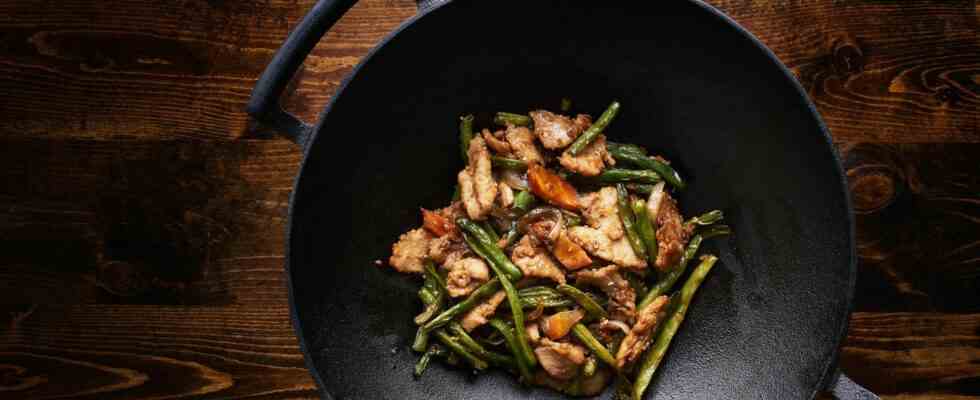It is a real all-rounder in the kitchen: Whether for roasting or steaming, cooking or deep-frying – numerous dishes can be prepared quickly but gently with the wok. However, the robust pan also has disadvantages.
A classic wok is made of cast iron, has a high rim that gets wider and wider towards the top and two opposite handles. There are now also models with only one long handle, but these are usually much smaller – otherwise you wouldn’t be able to lift the heavy wok (the term comes from the Cantonese language and means cooking utensil) with just one hand. In contrast to a standard pan, a cast iron wok has many advantages, but also a few weaknesses.
Amazon Basics
Cast iron wok: the advantages
- Due to its heat-resistant material, a cast-iron wok is particularly dimensionally stable. In other words: even at extremely high temperatures, the pan does not warp.
- The material is strong and durable, so you only have to buy a good cast iron wok once in a lifetime.
- A classic wok can conduct and store heat very well, even on the outer walls – this means that even large quantities of food are heated evenly.
- If the cast iron of your wok has been seasoned in advance, it even has a light non-stick coating.
Wok with handle
Cast iron wok: the disadvantages
- Due to its very good heat storage properties, the heat in a cast iron wok cannot be regulated so well. Once it’s hot, it can’t cool down quickly.
- Cast iron is a very heavy material. As a result, the classic wok is anything but lightweight and cannot be panned.
- A wok takes much longer to heat up than a regular pan. This means there is a risk that your ingredients will cook too quickly if the wok is really hot.
- Iron can rust, this also applies to the wok. In order to avoid this, the material should be regularly maintained – more precisely oiled.
Otto
How to care for a cast iron wok
As you have already learned, the wok requires special care – at least if it is made of cast iron and not stainless steel or aluminium. To avoid rust, the material should only be wiped out after use and not washed out. If there are stubborn incrustations on it, you can also use hot water, but you should avoid using washing-up liquid at all. Otherwise, the chemical cleaner would remove all oil residue from the wok remove and dry the material. This makes it more prone to rust stains. In addition, you would have to oil it more often, preferably with a vegetable oil. Ideally, do not use paper towels or towels, as the rough material on the wok could leave lint. Simply rub the oil into the iron with your fingers or the palm of your hand.
You might also be interested in:
- Why a coated pan is indispensable when cooking
- Easy Pan in the test: What good is the pan made of DHDL?
- Splatter guards for pans: How to prevent grease stains and burns
This article contains so-called affiliate links. There is more information here.

